by Coffee Kevin | Dec 16, 2016 |
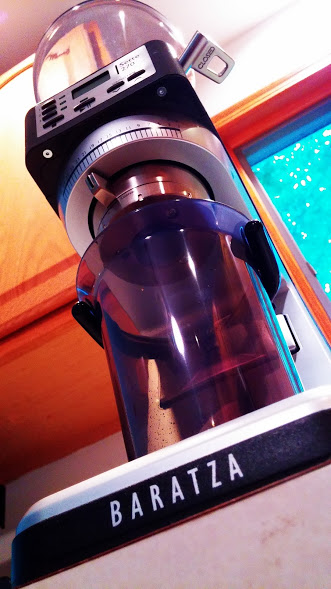 A coffee enthusiast is hard as a gift recipient. That’s because coffee or gear must be useful to make sense. Otherwise, get me socks or a new wallet. Thanks to the past few years, there are not only lots of great coffees, but lots of good gear gifts at all levels. Now, you can go through all my back reviews, but I’m purposefully going to give you a few new ideas. Some haven’t had full reviews yet, but they’re all worthy and will make someone very happy.
A coffee enthusiast is hard as a gift recipient. That’s because coffee or gear must be useful to make sense. Otherwise, get me socks or a new wallet. Thanks to the past few years, there are not only lots of great coffees, but lots of good gear gifts at all levels. Now, you can go through all my back reviews, but I’m purposefully going to give you a few new ideas. Some haven’t had full reviews yet, but they’re all worthy and will make someone very happy.
The great thing about giving gear is it’s likely to be there in the kitchen a year from now. Beans will not be. At least I hope not!
In no particular order:
Chemex Ottomatic Automatic drip brewer – This unit is recent, but really a re-creation of the original Chemex electric drip brewer. While not cutting edge circa 2016, it has a unique feature fans of the original claim is more important than simply delivering SCAA-approved water temperature. It repeatedly pauses during brewing, just like you do when you use a kettle and manual drip maker. The cost is high, but it’s hand-built in Ireland and if you like the Chemex taste footprint (and many do!), it’s the only choice if you want an automatic way to achieve that taste. Street price: $350
Handground Manual coffee grinder – A good grinder is one of the keys to great-tasting coffee. To update an old cliché, “What this country needs is an under-$100 grinder”. The Handground Manual coffee grinder might be just what this country needs. It’s well-thought out and engineered. While I haven’t yet tested it for 30 days, including a laser analysis test of the grind quality, in casual use, it’s done well, especially for medium fine grinds needed for manual pour over methods (not Chemex, though). There’s a real high quality ceramic burr inside and it’s under $100. If only my parents had gotten me one of these when I was going away to college. Street price: $79
Rattleware Cupping Brewer – This one floored me when Laura Sommers of Espresso Supply showed it to me in her office one day. We all like to analyze our coffees right? This one comes closer to replicating the taste of the fastidious cupping procedure than any other brewer I’ve tried. It allows you to steep the coffee and easily remove the grounds. It’s small and stows away for storage. Well made, and it’s inexpensive. Street price: $18.99
Behmor Plus 1600 roaster – I wrote about this years ago. It solves the number one issue with indoor home roasting north of the 35th parallel – smoke! That is, the Behmor really doesn’t emit any or at least not much in normal use. If there was a home roaster that would make home roasting a mainstream art, it’s this one. There are others, and they are good machines, but this one is the one that has all the features in one well-made chassis. Built to last, and I know because I still have the original and it works fine. If you want a brewer to match it, consider the Behmor Brazen Connected, which can download programming from hip roasters who can help you brew their top beans to perfection, taking this nuance-based hobby to another level. Street prices: Roaster: $369 Brewer: $199
Bunn MB Home Trifecta – Single/two cup automatic brewer. I got Bunn to bring a dozen of these to my very first CoffeeCon and, guess what? – they wouldn’t sell them, even to the foaming aficionados waving their credit cards! Still one of the best-kept secrets in the business, the Trifecta, originally hand-made from a Bunn employee’s child’s doll furniture, is one of those coffee business head-scratchers. It’s failed in the café business where they marketed it, but that’s because it’s really ideal in the home or office of someone who cares about coffee but has no time. It’s as easy to use as a K-cup, and makes a range of great-tasting coffee types. Costly, but not considering that it does – as close to a siphon as any automatic machine has ever made. Street price: $549
Cafflano Klassic – I keep wondering if this unit has made the penetration it should, but whenever I see these guys we just tell jokes and talk about coffee, not business. It’s the ideal bohemian coffee brewer. When they remake The Blues Brothers, wouldn’t Elwood make coffee to go with his toast using this brewer? It’s got a hand-grinder using a ceramic burr. It is so intuitive you really don’t need instructions. Best of all, it make one perfect cup of coffee. I have spotted them in offices, especially ones that have K-cup machines in the break room. Hehe. Street price: $95
Brewista BrewGlobal Smart Scale – You say you’re into coffee but still don’t own a scale? There are lots of them, but the Brewista is as good as any (they’re all accurate enough), and it is attractive as well. The idea is to do everything by weight. You weigh your grounds. You weigh the water. You weigh the final brew. Of course, you can do it however you want, but after using weight for a while, I doubt I’ll go back. Street Price: $59
Hario Next 5 Syphon – Hario’s v-60 dripper gets all the attention, but to me the jewel of their lineup is the syphon. When Oren Bloostein sent me some of his precious Guatemalan Geisha, I brewed it in the Hario Syphon. The Syphon, or siphon or vacuum as it’s been called over the years, is a high resolution brewing method, arguably the highest resolution brewing method of all. The physics of its design ensure all the grounds undergo equally probing extraction at industry-established ideal temperatures. This unit ships with two filter choices. The metal mesh filter is capable, but those of us who are fanatical will prefer the cloth, my favorite. The infrared heater is as costly as the brewer itself, but it completes the perfectionist’s quest and is much easier to use than a butane heater. Street prices: Syphon: $75 Infrared heater: $219
Moccamaster – Any model of Gerard Smit’s machine, still hand-built in The Netherlands, is worthy. They still lack some features of other brewers, but the basic principle is simple and effective. It is the best made coffee brewer of all time. It gets the water to 200F. It uses paper filters. It will likely last longer than you are likely to. It is costly, but there are sales (not at Christmas time though) and it will pay for itself over the years and you will never need another coffee maker. Street price: $299
Baratza Sette 270 – I have been testing this grinder for a couple of months. I am taking longer, not because it’s bad, but because it’s so good. It is the best grinding in its size you can get, period. It does something no other home grinder does well, espresso. I rekindled my interest in home espresso after testing (and tasting) its results. For a Hario syphon or Technivorm automatic drip, it does better than any other grinder except the giant and big-buck Mahlkonig EK-43 (something Patricia told me would not be acceptable to her for our kitchen). The only disappointment is it doesn’t go coarse enough for my Chemex preference, but I may be wrong. They claim it works. Hey, I’m not done testing. Hahaha Expensive but well-made and just a wonderful machine. Street price: $379
That’s my list. There are other worthy coffee gear items. These are all recommendable. Remember the most important thing isn’t the gear or the coffee. The most important thing is sharing your coffee with a friend.
Merry Christmas!
Podcast: Play in new window | Download
Subscribe: Android | Email |
by Coffee Kevin | Jun 16, 2016 |
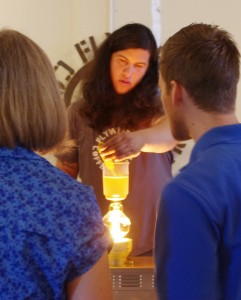 The Hario Syphon is perhaps the ultimate quality siphon, also long-known as a vacuum coffee maker. The Syphon works on the principal that near-boiling hot water in an enclosed lower vessel releases steam that expands, forces the hot water up through a tube into the upper bowl, where it is inherently the right temperature to brew coffee. As long as the lower bowl is kept heated, the water will stay up there, brewing coffee. The bubbling below causes the water in the upper bowl’s water to agitate the grounds, facilitating the extraction process. When the operator decides enough is enough, she simply removes all heat below and within about a minute the cooling and contracting vapors below cause the lower bowl to suck (hence the word vacuum) the finished brew back down into the lower bowl. Oh, did I mention there is always a filter between the two bowls? Haha, that alone is worth a patent. Siphons vary in the heating method (earliest samples were flame powered) material (glass is original and common, metal durable but no theater, plastic combines both benefits but it’s plastic) and filter type. The filter type is likely the most important of the variables to affect taste, and I’ll go into that later.
The Hario Syphon is perhaps the ultimate quality siphon, also long-known as a vacuum coffee maker. The Syphon works on the principal that near-boiling hot water in an enclosed lower vessel releases steam that expands, forces the hot water up through a tube into the upper bowl, where it is inherently the right temperature to brew coffee. As long as the lower bowl is kept heated, the water will stay up there, brewing coffee. The bubbling below causes the water in the upper bowl’s water to agitate the grounds, facilitating the extraction process. When the operator decides enough is enough, she simply removes all heat below and within about a minute the cooling and contracting vapors below cause the lower bowl to suck (hence the word vacuum) the finished brew back down into the lower bowl. Oh, did I mention there is always a filter between the two bowls? Haha, that alone is worth a patent. Siphons vary in the heating method (earliest samples were flame powered) material (glass is original and common, metal durable but no theater, plastic combines both benefits but it’s plastic) and filter type. The filter type is likely the most important of the variables to affect taste, and I’ll go into that later.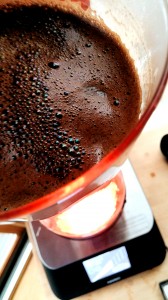 Should history ever agree to repeat itself in a different order, I’ve long felt the siphon would have been the ideal brewer to replace drip. After all, the siphon fixes the following drip issues:
Should history ever agree to repeat itself in a different order, I’ve long felt the siphon would have been the ideal brewer to replace drip. After all, the siphon fixes the following drip issues:
- Grounds to Water Ratios remain constant when making different size batches.
- Easy to maintain in-standard brewing temperature.
- Grind is less critical because it has no effect on contact time.
There may be other benefits too. But, in an effort to keep this review from taking my record for the all-time windiest, let’s now cut to our Hario version on the test bench. It’s a beauty all right. I promise not to let looks intoxicate me, but as with my marriage, I’m a sucker for looks. And this one’s a knockout. But, can it make coffee? And how! The Hario Syphon and its companion infrared heater are amazingly competent in that ability. This is a completely professional kit for any barista. Best of all, for the well-heeled devotee, it offers perhaps the ultimate home siphon setup. 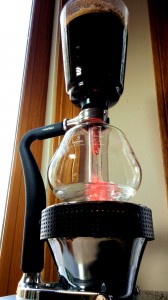 You get:
You get:
- A lower bowl on a sturdy metal stand. The glass is clearly a thick, robust, tempered type. The upper bowl’s stem (in my experience) is often prone to breakage, but with this unit so far, no such problem.
- Two filter types. You get the original cloth filter, that is most effective and (I think) the original method, offering the cleanest, clearest coffee. You also get a Hario-designed metal filter which effectively filters and apparently matches the flow rate of the cloth one, so they are interchangeable. More sediment but that’s what metal filters do. Much more convenient.
- Infrared heat. To me flames take too long, the liquid fuel is a hassle and flames vary in temperature due to air flow. To be honest, infrared still isn’t fast enough for me, but it looks beautiful and is wind resistant.
Say What You Think, Kev… I absolutely think this siphon is the best one I’ve yet used and I’ve used lots of them. It brews some of the best coffee I’ve ever had, which is saying a lot. But……… all siphon brewers I’ve yet tested have the following potential issues:
- Variable contact time. Try though I may, I find the idea of shutting off the heat and then expecting the coffee to dutifully drop back through that filter to the bottom again varies a bit. I’ve done pretty well overall. After some practice with this unit I was able to get a four minute contact time within fifteen seconds most of the time… but, not always. Compared to drip or other full immersion methods such as French press, the siphon varies more and I see no solution to this. I made one last batch before starting to write this review and I had a nearly six minute extraction. The coffee still tasted fine, but it is worth noting for those to whom it matters.
- The cloth filter is a hassle. Not this one in particular. All of them. If you’re an occasional user, it’s practically a no-go as storing the cloth filter requires cold water, a spot in the refrigerator to keep it cold, and frequent water replenishment. If you use the cloth filter often they are prone to absorbing built-up coffee tastes. The stainless filter, which I admit I used for most of my testing, allows fine sediment through. Paper, my personal filter material first choice is not an option. (Update: See below under tweaks for just such an option.)
- Heating, even with the fancy infrared heat source, is not fast. Compared to coffee brewers such as Bunn’s Phase Brew, Kitchen Aid’s KCM0802, OXO’s 12-cup Barista Brain and others that get the water to SCAA certified brew temps before contact begins, the room-to-ideal temperature on this siphon brewer using the Infrared heater is roughly ten minutes. Too long. I learned quickly to heat the water in a separate kettle first. Solves the problem and not that big a hassle, but still an extra step.
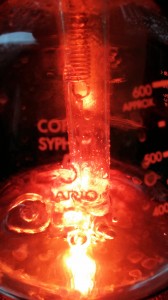 So, recommended or not? I will never knowingly write anything but the truth in this blog. While I acknowledge that this brewer still requires more active concentration from the end user, I also know it makes some of the best coffee I’ve yet tasted. No getting around it. For ultra-fresh coffee, very good quality coffee, roasted to its more flavorful degree, the Hario Syphon does a unique job. Carefully used, you can get a very thorough extraction, full of fruit and complexity. You truly feel you are tasting deep into the coffee. So, yes, highly recommended, with the caveat that you must become part of the task of brewing it. It is not yet truly automated in this product, and if used in a way that is automated, you are, in my opinion, giving up flavor in exchange. How Do I Use It? There are lots of ways to use a siphon or vacuum brewer. Here’s my personal method.
So, recommended or not? I will never knowingly write anything but the truth in this blog. While I acknowledge that this brewer still requires more active concentration from the end user, I also know it makes some of the best coffee I’ve yet tasted. No getting around it. For ultra-fresh coffee, very good quality coffee, roasted to its more flavorful degree, the Hario Syphon does a unique job. Carefully used, you can get a very thorough extraction, full of fruit and complexity. You truly feel you are tasting deep into the coffee. So, yes, highly recommended, with the caveat that you must become part of the task of brewing it. It is not yet truly automated in this product, and if used in a way that is automated, you are, in my opinion, giving up flavor in exchange. How Do I Use It? There are lots of ways to use a siphon or vacuum brewer. Here’s my personal method.
- Heat four cups of water in an electric kettle to 200°F.
- Weigh 38 grams fresh roasted beans and grind them a coarser than auto-drip but a notch or two finer than for Chemex drip (coarse).
- Once water is heated to 200°F, transfer it to the empty glass bottom half and place on infrared heater. Turn heater on to maximum or one notch less.
- Place empty upper mixing vessel with filter inserted into lower half so that they fit snugly together.
- After water has completely risen scoop or pour grounds into top half. Very gently stir near top to ensure all grounds are wet. Start timer.
- At one minute begin another few seconds of stirring. Do not stir downward, as I found if you do, there’s a risk that some amount of brewed coffee will work itself down into the bottom half. Reduce heat a few notches after stirring.
- At two minutes stir gently again. Lower heat a notch or two.
- At three minutes, stir one last time.
- At around three-twenty, turn off heat. After a few seconds, the coffee will begin its final descent into the lower bowl, which becomes a server upon completion.
- When the coffee has completely returned to the bottom, carefully unplug the upper bowl, remove it and place it in the top coffee, which when upside down, becomes a holder for the spent grounds.
- Serve.
Tweaks
You should know that I notice a significant difference between using a cloth and metal filter. The cloth does a more thorough job removing grounds, some might say ideal, although I’ve been around coffee long enough to know that ideal is a subjective term. Let’s just say it’s my favorite. At the recent CoffeeCon NY festival I noticed Georgio’s Coffee’s Georgio Testarossa using a siphon to brew his own delicious fresh-roasted coffee. I also noticed the brew’s viscosity matched my own using the cloth filter. I asked if he was using cloth. “No, paper”, he responded. “Paper”, I exclaimed. Then he disassembled his filter to reveal how he’d cut matching circles from a Bunn filter. 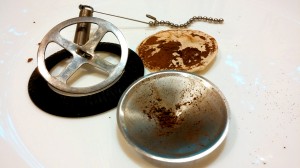 Some people use fine grind for vacuum. I used to, but lately I’ve found a coarser grind to work best. Siphons can use any grind as grind really does little to affect contact time. Of course surface area exposure affects the taste strength; that remains. Using the metal filter I find the coarse grind reduces particles in your cup. I use close to what I’d use for regular drip.
Some people use fine grind for vacuum. I used to, but lately I’ve found a coarser grind to work best. Siphons can use any grind as grind really does little to affect contact time. Of course surface area exposure affects the taste strength; that remains. Using the metal filter I find the coarse grind reduces particles in your cup. I use close to what I’d use for regular drip.
Conclusion
The Hario Syphon is a gorgeous brewer that can make state-of-the-art coffee. I had both the single-knob and digital control base units. I found each to work well. The digital control unit will appeal to anyone who enjoys its programmable features, although to be honest, I didn’t explore them. Different article. The filter options are enough to make me choose this vacuum unit. I never felt the glass was fragile and had no incidents nor near-incidents during my tests. About the only thing missing compared to drip pour-over such as a Hario V60 is the ease of controlling brewing temperature. Vacuum/siphon is high-temperature brewing, inherent in the process. But the results are impressive. Any time during my time with this unit that anyone came to visit they immediately noticed the unit. Whenever I offered to make coffee and asked if they had a preference, the unanimous response was to point directly at the Syphon and say, “That one!”
Unhesitatingly, highly recommended.
by Coffee Kevin | Mar 16, 2016 |
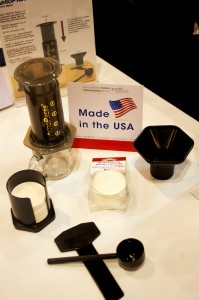 The International Housewares Show is another important trade show for coffee, yet it seems to attract few other coffee journalists. Why? I assume it is because many writers are still stuck thinking coffee is just another beverage ala wine or beer. Those items are brought to their final greatness, then sealed in packages until consumers open and drink them. Period. Coffee is different and a key to its greatness is the final brewing step. At a café, this is someone else’s challenge. At home, where 70% of it is consumed according to the National Coffee Association, the brewing equipment is an obvious dramatic ultimate creator of coffee flavor as it conducts the alchemy which extracts the glorious complex notes from our prized coffee beans. This year’s Housewares show featured a number of important pieces of gear that those of us who know of brewing’s role, will find beneficial to our quest to enjoy the world’s best coffee at home. Here’s my short list:
The International Housewares Show is another important trade show for coffee, yet it seems to attract few other coffee journalists. Why? I assume it is because many writers are still stuck thinking coffee is just another beverage ala wine or beer. Those items are brought to their final greatness, then sealed in packages until consumers open and drink them. Period. Coffee is different and a key to its greatness is the final brewing step. At a café, this is someone else’s challenge. At home, where 70% of it is consumed according to the National Coffee Association, the brewing equipment is an obvious dramatic ultimate creator of coffee flavor as it conducts the alchemy which extracts the glorious complex notes from our prized coffee beans. This year’s Housewares show featured a number of important pieces of gear that those of us who know of brewing’s role, will find beneficial to our quest to enjoy the world’s best coffee at home. Here’s my short list:
Behmor’s Joe Behm has single-handedly driven the coffee brewing world to new heights. Before Joe, the brewing world seemed to sit on its collective hind end and got hung up adding alarm clocks other useless features to its products. Joe created the first multiple temperature brewer, the first once since the lengendary Chemex Automatic that had pre-infusion (for fresh-roasted/fresh-ground coffee). Joe’s Behmor brewer was the first I ever tested that acknowledged the fact that anyone living in high-altitude cities wasn’t able to brew at near ideal water temperatures and added an attitude setting. This past year, Joe became the first one to issue a coffee brewer that can be operated by your smart phone. Before you say, “so what?” and wags issue lame jokes about our modern society not being able to press the “on” button, let me quickly explain what this really means. It means being able to control many variables too numerous to accomplish simply by adding buttons. It means taking advantage of the phone’s better interface to those features, which will soon include not only brewing temperatures and pre-infusion times, but things heretofore only available to manual craft brewers, such as rest periods between pours during brewing. 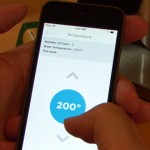 Best of all, and most important in my view, is the connected feature that lets your favorite roasters upload their own personal favorite brewing parameters to the Behmor website. Let’s explore this scenario: Let’s say Jeff Duggan at LA’s Portola roasters decides that his latest Panama Geisha is ideally brewed at a temperature of 197°F. When it’s brewed within its ideal window of fourteen days from roast, it requires a 1 ½ minute pre-infusion of water to settle the grounds before brewing starts; after that it does best with a fifteen second spacing between pours throughout the brew cycle. Then Jeff uploads those parameters to the Behmor web site, aside other similar instructions for various beans. You go there using your phone app, download it and press go. The Brazen Connected brewer just went from being one of the most extensive to use to being one of the simplest. That’s why it’s important.
Best of all, and most important in my view, is the connected feature that lets your favorite roasters upload their own personal favorite brewing parameters to the Behmor website. Let’s explore this scenario: Let’s say Jeff Duggan at LA’s Portola roasters decides that his latest Panama Geisha is ideally brewed at a temperature of 197°F. When it’s brewed within its ideal window of fourteen days from roast, it requires a 1 ½ minute pre-infusion of water to settle the grounds before brewing starts; after that it does best with a fifteen second spacing between pours throughout the brew cycle. Then Jeff uploads those parameters to the Behmor web site, aside other similar instructions for various beans. You go there using your phone app, download it and press go. The Brazen Connected brewer just went from being one of the most extensive to use to being one of the simplest. That’s why it’s important.
Bonavita is distributed by Espresso Supply. This is good because Espresso Supply has very close contact with many roasters, some who’ve become for the first time comfortable carrying and endorsing an electric home automatic drip brewer. The public too, has become very comfortable with SCAA industry-certified automatic home brewers thanks to Espresso Supply. They distribute Bonavita gear and make some of their own. They also introduced two reusable K-cups, a plastic one made in the USA and a stainless version not made in USA. I snared a sample and will test it soon. A new Bonavita 5-cup brewer is undergoing my testing right now.
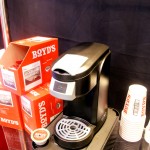 Boyd’s Coffee Company distributes Behmor, and so shared their booth with Joe Behm and with their own TechniBrew International brand. Boyd’s is an unusual coffee company because they are a large wholesaler and coffee brand, especially strong in the Pacific Northwest, but also employ engineers and have a piece in other coffee brewers. One, which I think they own but are branding through the name TechniBrew (they used to be the Technivorm’s US distributor) is a K-cup pod brewer. Before this publication’s fans stop reading, you should know that this one possibly deserves your attention for two reasons. First, although I have not yet officially tested it for review, Boyd’s designed it to fully meet industry brewing standards. I’ve tested one other K-Cup pod brewer that claimed this (made by Bunn) and that unit did prove to me that much of the coffee aficionado’s distaste for this format is due to lackluster brewers that use it, not the format itself. Inventor/Engineer Dave Wheeler of Boyd’s told me the TechniBrew K-cup brewer will meet all SCAA Brewer certification standards. Please note: The SCAA does not review nor certify K-cup brewers. In a casual tasting at their booth, I must say I did find the coffee of a different level than with other K-cup brewers, but of course that is a totally unscientific and anecdotal comment. Boyd’s also designed their K-cup products so they are 100% compostable. From an environmental point of view, this is even more significant.
Boyd’s Coffee Company distributes Behmor, and so shared their booth with Joe Behm and with their own TechniBrew International brand. Boyd’s is an unusual coffee company because they are a large wholesaler and coffee brand, especially strong in the Pacific Northwest, but also employ engineers and have a piece in other coffee brewers. One, which I think they own but are branding through the name TechniBrew (they used to be the Technivorm’s US distributor) is a K-cup pod brewer. Before this publication’s fans stop reading, you should know that this one possibly deserves your attention for two reasons. First, although I have not yet officially tested it for review, Boyd’s designed it to fully meet industry brewing standards. I’ve tested one other K-Cup pod brewer that claimed this (made by Bunn) and that unit did prove to me that much of the coffee aficionado’s distaste for this format is due to lackluster brewers that use it, not the format itself. Inventor/Engineer Dave Wheeler of Boyd’s told me the TechniBrew K-cup brewer will meet all SCAA Brewer certification standards. Please note: The SCAA does not review nor certify K-cup brewers. In a casual tasting at their booth, I must say I did find the coffee of a different level than with other K-cup brewers, but of course that is a totally unscientific and anecdotal comment. Boyd’s also designed their K-cup products so they are 100% compostable. From an environmental point of view, this is even more significant.
It’s a little known fact that Brewista is the brainchild of Brian Gross, likely as close as the coffee world has to a Henry Ford. Brian is a genius and inventor. He is co-owner of BonaVita, whose coffee makers are the current everyman’s favorite, but created Brewista as if he became bored with owning just one great company. Brewista even seems to compete with Bonavita on some levels, something I can’t say I understand. Brewista makes the only coffee brewer other than AeroPress which is made in the USA, Cheyenne, Wyoming to be precise. It’s called the Brewista Steeping Filter, and it is a hybrid steep and drip manual pourover. They’ve also got a number of kettles, scales, and other gear. While Brian seems to be aiming Brewista to mostly be lower-cost Bonavita equivalent gear, he revealed an inventive variable spout kettle that allows the user to control flow and thrust. I know of at least one prominent end user who eschews goose-neck kettles for his Chemex pours because he can’t get enough flow and power in order to “push the grounds around” (their words). Most interesting to me is that Brian is developing different paper filter grades to appeal (I think) to different folks’ tastes on filter. More on that as I learn more from Brian. If you listen to the podcast clip you’ll understand why I can only process a percentage of Brian’s mind while he’s on a roll.
Bunn exhibited a newer, simplified and less expensive single cup Trifecta. They’ve taken their previous two buttons, one controlling time and the other turbidity (using air blown through the brew chamber to stir things up) and made a single button that combines the two. While I despair at losing any functionality of this brilliant and unique machine (both Bunn’s commercial and home marketing teams really blew it in my humble opinion), I think the single button might be justified if it brings the Trifecta into spitting price distance of say a Technivorm, whoops – MoccaMaster. Coleman Garcia brought several new
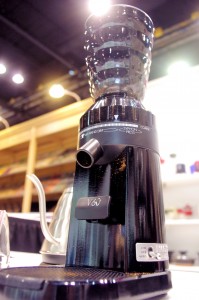 Hario products to IHA. One was actually premiered at CoffeeCon LA in January, well ahead of this trade event. It’s a programmable infrared heater for the Hario Siphon. While their previous product is functional and makes a compelling statement to the already visual home theater experience of making coffee, this new unit offers a touch screen and it’s able to record user information, including the ability to record and repeat your personal siphon brewing method and timings, making it even more beautiful. Suggested retail pricing will be $500. It is awaiting US approvals, but I predict it will be a big seller among this method’s fans. Hario has introduced metal V60s and accompanying matching black, gold and silver aluminum stands. I may be fine with my plastic version, but I also expect these to move into home setups soon. They had their already-well known Mizudashi Immersion cold coffee Brewer there as well. Finally, Hario introduced a home grinder, optimized to accompany and even grind directly into a V60 cone. It also features front panel indicators for Press, V60 and Siphon. While Coleman humbly referred to it as a brand extension, I can imagine a lot of interest as their core audience is sophisticated enough to appreciate a grinder and has a fervent interest in any product labeled Hario, similar to the Apple brand allure.
Hario products to IHA. One was actually premiered at CoffeeCon LA in January, well ahead of this trade event. It’s a programmable infrared heater for the Hario Siphon. While their previous product is functional and makes a compelling statement to the already visual home theater experience of making coffee, this new unit offers a touch screen and it’s able to record user information, including the ability to record and repeat your personal siphon brewing method and timings, making it even more beautiful. Suggested retail pricing will be $500. It is awaiting US approvals, but I predict it will be a big seller among this method’s fans. Hario has introduced metal V60s and accompanying matching black, gold and silver aluminum stands. I may be fine with my plastic version, but I also expect these to move into home setups soon. They had their already-well known Mizudashi Immersion cold coffee Brewer there as well. Finally, Hario introduced a home grinder, optimized to accompany and even grind directly into a V60 cone. It also features front panel indicators for Press, V60 and Siphon. While Coleman humbly referred to it as a brand extension, I can imagine a lot of interest as their core audience is sophisticated enough to appreciate a grinder and has a fervent interest in any product labeled Hario, similar to the Apple brand allure.
 I almost missed them – I keep forgetting that Technivorm is really MoccaMaster. The machines haven’t changed and they likely won’t, and to this brands fans that’s a good thing. MoccaMaster stubbornly refuses to embrace frivolous new features, although some of them in my opinion contribute to taste, but no one can deny they make a great product. They are still hand-built in the Netherlands. They have stuck to all copper heating elements, arguably the best and safest to health. Oh, there is a new color one to add to their array of beautiful ones. A beautiful machine in a geeky way.
I almost missed them – I keep forgetting that Technivorm is really MoccaMaster. The machines haven’t changed and they likely won’t, and to this brands fans that’s a good thing. MoccaMaster stubbornly refuses to embrace frivolous new features, although some of them in my opinion contribute to taste, but no one can deny they make a great product. They are still hand-built in the Netherlands. They have stuck to all copper heating elements, arguably the best and safest to health. Oh, there is a new color one to add to their array of beautiful ones. A beautiful machine in a geeky way.
While all pod machines presume unproven assertions that pre-ground coffee can be kept fresh in those pods, both Nespresso and Illy pod machines have proven to my taste buds that they are capable extractors of taste, given you like the taste they are engineered to deliver. This year, Nespresso has added the connected feature, meaning you can use and app to program, start and keep track of onboard pod inventory with your smart phone.
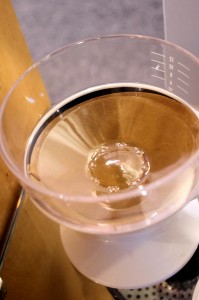 The 12-cup OXO brewer I reviewed recently was getting a lot of attention. Last year OXO brought prototypes and this year they’re all working and their two top brewers earned SCAA certification. To me, the pride of earning this honor with your first machine and one that is able to make 12 cups is noteworthy. OXO’s grinder is also noteworthy because theirs equals a higher priced Baratza grinder (in our grind results tests). One brewer they had that’s spanking new was the OXO Autodrip pourever coffee maker, which makes 6 – 12 ounces of brewed coffee using an innovative cup-marked overhead water reservoir to eliminate guesswork, and which also have a dozen smaller drip holes in order to spread the shower over the grounds. OXO’s Dave Lionetti also told me they’ve played with alternating size and patterned drip holes, which he says enhances the way water falls, agitates and steeps the grounds, which results in a better tasting cup of coffee.
The 12-cup OXO brewer I reviewed recently was getting a lot of attention. Last year OXO brought prototypes and this year they’re all working and their two top brewers earned SCAA certification. To me, the pride of earning this honor with your first machine and one that is able to make 12 cups is noteworthy. OXO’s grinder is also noteworthy because theirs equals a higher priced Baratza grinder (in our grind results tests). One brewer they had that’s spanking new was the OXO Autodrip pourever coffee maker, which makes 6 – 12 ounces of brewed coffee using an innovative cup-marked overhead water reservoir to eliminate guesswork, and which also have a dozen smaller drip holes in order to spread the shower over the grounds. OXO’s Dave Lionetti also told me they’ve played with alternating size and patterned drip holes, which he says enhances the way water falls, agitates and steeps the grounds, which results in a better tasting cup of coffee.
Those are highlights. I reserve the right to add more if I think of them, but those stood out and, once again, Housewares proves to be a great place for coffee brewing products. #Housewares 2016.
by Coffee Kevin | Mar 4, 2016 |
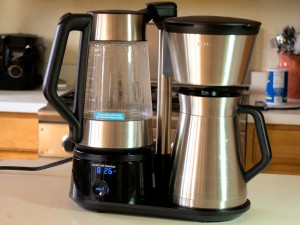 Once upon a time, the way to brew 12 cups of coffee at one sitting was owned by Bunn and its use of always-hot water to make it possible to deliver 200°F (+/-5°) water to a grounds basket and run it through the grounds in an impressive three minute window. A consumer falling-out with the standby mode and a misunderstanding of contact time by consumers, retail appliance buyers and Bunn’s competitors caused these units to be discarded, although if you look through Bunn’s current lineup, there may be a brewer in there that still follows this general principle. But, I’m unnecessarily distracting you from our guest of honor and that’s this new OXO machine, which solves a few of the problems and limitations of earlier big batch consumer brewers, and is at once a leader in this category. Let’s go through its features and then discover how it does in actual kitchen testing and tasting.
Once upon a time, the way to brew 12 cups of coffee at one sitting was owned by Bunn and its use of always-hot water to make it possible to deliver 200°F (+/-5°) water to a grounds basket and run it through the grounds in an impressive three minute window. A consumer falling-out with the standby mode and a misunderstanding of contact time by consumers, retail appliance buyers and Bunn’s competitors caused these units to be discarded, although if you look through Bunn’s current lineup, there may be a brewer in there that still follows this general principle. But, I’m unnecessarily distracting you from our guest of honor and that’s this new OXO machine, which solves a few of the problems and limitations of earlier big batch consumer brewers, and is at once a leader in this category. Let’s go through its features and then discover how it does in actual kitchen testing and tasting.
- Batch Size = real 12 cups – This brewer makes an actual 12 cups of coffee and they went with the larger 5 ounce cup size, not some metric variant claimed to be from Europe, which translates into four ounces or less in order to create false confidence. If you have 12 guests or a half-dozen who’d like a second cup, you’re in for a treat.
- Water heater/Kettle – through an ingenious design, OXO has created a water heater that’s removable and can be used as a separate kettle.
- Water scale – the kettle is actually sitting on a scale that automatically weighs the water and selects the batch size.
- Adjustment of drip parameters to accommodate various batch sizes.
- Brewing temperature adjustment. This is a big benefit, and more about it later.
How does it all perform?
- Batch size – works well in that, as mentioned before, honestly calls a cup a cup.
- Water Kettle – it works like it says it does and gives the consumer two appliances they might normally need, which goes some to make up for the brewer’s somewhat larger than usual footprint.
- Water scale – works well and fooled me. I forgot about it a few times and didn’t trust it to choose the batch size. Once I got comfortable with its doing this step for me, things were easy.
- Adjustment of drip parameters – no matter what batch size I chose, the contact time was three minutes. This is actually a bit fast for those used to Chemex or most other automatic drip coffee makers. You might consider a slightly finer than usual grind in order to ensure your coffee is fully extracted. But, yes, it works, and I’m still not sure quite how, as I can’t really see inside the brewer while it’s functioning.
- Brewing temperature adjustment – This is a wonderful feature, especially for those of us spoiled by using our own temperature adjustable kettles when brewing manually. I found 198°F to work ideally when brewing Metropolis Coffee’s Honduras from Mario Doreteo Perez at Finca Guamilito. When I brewed Old Soul’s Papua New Guinea – Aiyura Plantation coffee, I found 202°F really brought forth the bright notes in this surprisingly fruity Indonesian coffee.
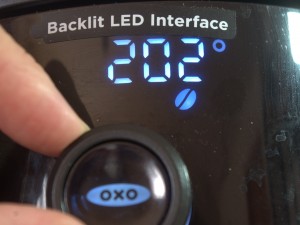
Tasting tests I’m in a testing phase right now with several (including a second OXO model) other brewers on the bench. I had one coffee in house, the aforementioned Metropolis Honduras from Mario Doreteo Perez. Fortunately, it is a very fine one. Its beautiful fruit and nut notes came through loud and clear with this maker. As I’ve found with most shorter-extraction-time brewers, the bitterness really gets down to the null point. So did even the two degrees below 200°F as a brewing temperature. 198°F just offers a little more fruit, a little less tang. It’s a well-known trade secret that different beans and roasts perform optimally at different temperatures. The great news is if you can play with this or not; it’s up to you. We used this brewer for several large family gatherings over the holidays and I found it very easy to use and deliver a large batch of delicious coffee. I had to get used to turning it on, as you need to turn the knob to brew so it doesn’t just boil water for its other role, but once you get used to it, it’s really quite intuitive. I was worried that the cupcake filters I found at the supermarket would be undersized, especially given the rather short contact time. Yet, the coffee level, while extremely close, never rose above the line and overflowed inside the basket, a sign of good engineering. Notes: I notice OXO chose a cupcake/flat bottomed filter for this brewer. I have always preferred this filter style. While there are V-shaped filter brewers that meet their specs and brew fine coffee, I think the flat-bottom style does the most to prevent an over-extraction point in the brew basket. It does require 12-cup filters, and ideally you can find these at a restaurant supply house, where they should be, if anything, less expensive per brew than v-style filters from a grocer.
The decision to have the brewer start from cold instead of a constant always-on mode is likely a good one. The fact is it still means only about a twelve minute start-to-finish brewing time and that means it rivals many other twelve cup automatic machines, and many of those never reach the optimum brew temperature, and meanwhile over-extract as they start right away (tepid water and all) and extend the contact time throughout the twelve minute brew cycle. My best brewing results occurred using the full batch recipe of 100 grams medium fine grind coffeee, slightly coarser than I would grind for say a v-shaped filter try automatic drip brewer such as a Technivorm. I realize the OXO uses a shorter duration contact time between water and grounds, and so it is counter-intuitive, but I’m just reporting culinary taste results, not attempting to justify them. Your mileage may vary and I always encourage others to tweak theirs and report back. Conclusion – If this is OXO’s first effort, it is a very good one. Apparently the Specialty Coffee Association agrees with me, as they certified it, not bad for a first effort. haha Simply, I would put the OXO 12-cup at the top of my list for a twelve cup automatic drip brewer. Highly recommended.
by Coffee Kevin | Mar 12, 2015 |
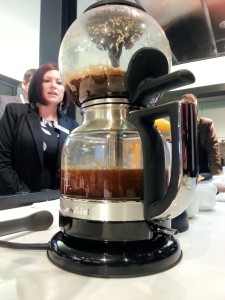 I keep saying that if you don’t get into coffeemakers, your coffee at home will never be great. The best trade show for the gear isn’t a coffee show at all – it’s the International Housewares Show.
I keep saying that if you don’t get into coffeemakers, your coffee at home will never be great. The best trade show for the gear isn’t a coffee show at all – it’s the International Housewares Show.
It’s where I discovered the Chemex, the Aeropress, KitchenAid’s legendary 4-cup, Bonavita, Technivorm and of course my first Bunn, the A10. Not bad for one event! They don’t really want consumers here. I get to go because I keep writing this blog and various articles. Even I used to get ignored because the sellers are always on the lookout for Macy’s buyers. Can’t blame them. I ask a hundred questions and might buy one, where department store buyers are going to buy a case for each store. It keeps me humble.
This year’s event had several new, innovative products. Let me give you a quick (by my standards) rundown. None are reviews. I sometimes look back at first-tastes and see them for the infatuations they are. I believe in long courtships regarding coffeemaker testing. 30 days is the minimum, and it reduces/eliminates new car smell, packaging, and gives me time to do old fashioned things like read the instruction book and tweak products a bit before shooting off my pen, figuratively speaking of course.
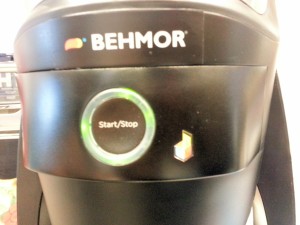 Behmor won the Innovation Award, Kitchen Electrics, International Housewares show award for Joe Behm’s Brazen Connected 8 Cup Brew System. I was perhaps the first to review the Behmor Brazen, so you already know its leading edge position among brewers for its variable temperature setting, variable pre-infusion times (you can actually brew same-day roasted coffee without foaming overflows!) and altitude settings, which likely mean nothing to New Yorkers or Chicagoans, but are the only way to achieve SCAA-recommended brewing temperatures in Denver. Joe won his award (which kept him from showing up at CoffeeCon NYC) for the brand-new “connected” version of his brewer.
Behmor won the Innovation Award, Kitchen Electrics, International Housewares show award for Joe Behm’s Brazen Connected 8 Cup Brew System. I was perhaps the first to review the Behmor Brazen, so you already know its leading edge position among brewers for its variable temperature setting, variable pre-infusion times (you can actually brew same-day roasted coffee without foaming overflows!) and altitude settings, which likely mean nothing to New Yorkers or Chicagoans, but are the only way to achieve SCAA-recommended brewing temperatures in Denver. Joe won his award (which kept him from showing up at CoffeeCon NYC) for the brand-new “connected” version of his brewer.
With the Behmor Connected you will be able to go online and download Counter Culture’s (or other roaster’s) recommended settings for his brewer. This means even more. I can envision barista champs blogging their favorite recipes and settings for coffees ala celebrity chefs (that they really are of course) and finally being able to achieve at home exactly what they are doing in the cafes. Meanwhile, it should double Behmor’s market because more casual consumers who just care about taste, not geeky tweaking, and give them easy downloads to load.
An interesting new startup is Brewista, the brainchild of Bonavita co-owner and inventor, Brian Gross. Brian is one of the great minds of coffee brewing. He talks faster than anyone I’ve ever known, and it’s all content. He’s establishing a coffee product innovation think tank, and future manufacturing site in Cheyenne, Wyoming! He’s releasing a line of simplified Bonavita products that will feature fewer features, and lower costs to bring things like their kettles to a wider audience. Brian is working on online interconnectivity with coffeemakers, which means more sophisticated brewing and simplified operation for sleeping early-morning operators. The thing that he was most excited about was his onsite coffee shop almond milk extractors for cafes. Of course, a home version cannot be far behind. Keep an eye on Brewista. Brian has a great track record with Bonavita, and among coffee’s best overactive imaginations.
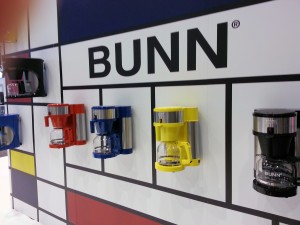 Bunn had a wall of colorful brewers. At first I thought they’d kidnapped an Italian designer and brought them to Springfield, but it turns out they were only for display. They did have their home Trifecta on hand. I can’t help continuing to believe they should sell those in a Bose-style direct program (the pricing/profit margins are too low for mainstream retailers, even so-called high end ones like Sur La Table or Williams-Sonoma). A Connected Trifecta has to be in the works, but if it is, they’re keeping mum about it. Hope they walked the show.
Bunn had a wall of colorful brewers. At first I thought they’d kidnapped an Italian designer and brought them to Springfield, but it turns out they were only for display. They did have their home Trifecta on hand. I can’t help continuing to believe they should sell those in a Bose-style direct program (the pricing/profit margins are too low for mainstream retailers, even so-called high end ones like Sur La Table or Williams-Sonoma). A Connected Trifecta has to be in the works, but if it is, they’re keeping mum about it. Hope they walked the show.
Bunn still makes the best tasting K-cup machine I’ve yet tried. It hits the 196°F mark easily, and, used in tea (pulse) mode, does a very nice cup. iCoffee is my single nod to K-cups. I lost interest in Keurig after they released the 2.0. It has the faults of the first generation, and some new bad habits like the locking mechanism that forces you to use mediocre coffees. Too bad too, because there are some good local roasters churning out fresher, higher quality K-cups. The Keurig 2.0 is not a bad machine, in fact it is amazing for what it does, but it was designed to expand its use for many beverages, soups etcetera. It makes good (not great) coffee.
iCoffee, brainchild of Bruce Burrows, who purchased the old Remington name (they used to be a high quality coffeemaker brand). The iCoffee does extract more thoroughly than Keurig’s or most other K-cup machines. And it uses any K-cup, just as Bunn’s does, so there’s no problem filling it with the really good ones coming out. Who’s got good K-Cups? La Minita’s own brand of K-Cups, made with proprietary filters made from surgical fabric and recyclable after peeling foil, are the best I’ve yet tried. I know K-Cups are under ecological and sensory fire, but they are market reality and, as Mc Alpin and Boyd’s have proven, can be made recyclable.
KitchenAid hosted a little reviewer party one morning at their nearby (it’s not that near) showroom. I was just wowed when KA Product Development Manager Meighan McLaughlin started brewing for me with their new Siphon (vacuum) coffee maker. It has automatic cycle, a permanent filter, and has a glass top, yet features steel reinforcement at the traditionally weak points. KitchenAid also has a new grinder, with claimed burr refinement. There’s even a new KitchenAid French press which operates on AA batteries.
 I’ve saved Oxo for last. Oxo makes a lot of rubber-sided kitchen hand tools. I have their can opener, and nothing else, but it works well. So what are they doing in the coffeemaker business? Apparently, according to their charming French Senior Product Manger, Claire Ashley, they decided to enter the coffeemaking market after analyzing the current one and realizing how mediocre most coffeemakers are. Obviously, CoffeeCompanion fans know this, and also know I simply ignore most of the ones that can’t extract properly, but having searched last year for my Consumer’s Digest report, I can say that likely 80% of the ones in mainstream department stores are genetic failures in the kitchen.
I’ve saved Oxo for last. Oxo makes a lot of rubber-sided kitchen hand tools. I have their can opener, and nothing else, but it works well. So what are they doing in the coffeemaker business? Apparently, according to their charming French Senior Product Manger, Claire Ashley, they decided to enter the coffeemaking market after analyzing the current one and realizing how mediocre most coffeemakers are. Obviously, CoffeeCompanion fans know this, and also know I simply ignore most of the ones that can’t extract properly, but having searched last year for my Consumer’s Digest report, I can say that likely 80% of the ones in mainstream department stores are genetic failures in the kitchen.
Oxo first showed me their grinder; that they showed me the grinder first is a good sign. It has a built-in scale and automatic shutoff by weight. The upper beans bin is removable and sealable. If it grinds properly, (only testing can determine this) they might really have a powerful entry. They are introducing two coffeemakers. First, the 1 liter one has a glass tube so water at its hottest never touches plastic (although the grounds holder is BPA-free plastic). They have also developed algorithmic internal software that allows you to do various batch sizes and still deliver the same grounds/water contact time. This results in consistent tasting brew, whether you make two cups or eight. If it works as promised, it’s a great feature.
The second model offers a larger 12 – 4.5 oz cup batch size. According to Ms Ashley, Oxo designers recognized the heating limitations creating enough pumped hot water to do this, which she says is impossible with current technology. So, they are heating all the water at once, and then release it at approved brewing temperature. Both brewers feature tubes to release brew at carafe bottom in order to mix coffee before pouring. An unusual innovation is a transformer feature where you can remove the boiler and use it as a water kettle. Exciting!
As Sherlock Holmes, and later Carly Simon, say: These are the good old days!
 A coffee enthusiast is hard as a gift recipient. That’s because coffee or gear must be useful to make sense. Otherwise, get me socks or a new wallet. Thanks to the past few years, there are not only lots of great coffees, but lots of good gear gifts at all levels. Now, you can go through all my back reviews, but I’m purposefully going to give you a few new ideas. Some haven’t had full reviews yet, but they’re all worthy and will make someone very happy.
A coffee enthusiast is hard as a gift recipient. That’s because coffee or gear must be useful to make sense. Otherwise, get me socks or a new wallet. Thanks to the past few years, there are not only lots of great coffees, but lots of good gear gifts at all levels. Now, you can go through all my back reviews, but I’m purposefully going to give you a few new ideas. Some haven’t had full reviews yet, but they’re all worthy and will make someone very happy.

















